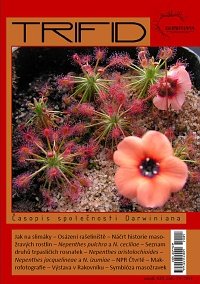Obsah
Trifid 2014/3&4
- volume 19
- ISSN 1214-4134
- pages 64
- closing date 30.11.2014
Peat Bog Gardening with Carnivorous and Companion Plants
Zdeněk Aksamit
Zdeněk was gathering useful and worth information about bog gardening for a longer time. How to build it, what to do better and what to avoid etc. Zdeněk’s first bog is dated back to the year 2010 and now it is the time to read more about it. He split the bog by a water area into two parts; operationally called as Eurasia and America. However, species selection is extraordinary critical due to sometimes inclement weather conditions in the Czech Republic and our effort to meet all plants’ needs.
A Brief History of Research into Carnivorous Plants and Another New Observations and Findings
Karol Gazdík
Let’s look together with our colleague from Slovakia at the historical observations of the carnivorous syndrome in plant species. It was Charles Darwin who suggested many plants may indeed be carnivorous. He focused on sundews and the ability to move their sensitive tentacles in response to contact with prey. But he used also Pinguicula vulgaris in his science experiments, fascinated by its leaf-margin rolling ability. And this is just the beginning…
Nepenthes pulchra & Nepenthes ceciliae, two new pitcher plants discovered in the Philippines
Dr. Thomas Gronemeyer, David Marwinski & Marius Micheler
In August 2011, Dr. T. Gronemeyer, D. Marwinski and M. Micheler had visited the island Mindanao to search for new pitcher plant species. And they succeeded! On Mount Kiamo, they revealed two spectacular new species. Nepenthes ceciliae shares similarities with N. copelandii, but is smaller and has several distinct morphological features. N. pulchra has a similar morphology to N. petiolata, however N. pulchra is bigger and has strongly decurrent leaf attachments.
An Updated List of Pygmy Sundews Species
Jiří Havrda
Based on the Carnivorous Plants of Australia Magnum Opus trilogy, Jiří created an updated list of pygmy Drosera as Lowrie’s up-to-date examination of all carnivorous plants from Australia brought us new pygmy species and some other species were renamed.
A New Way How to Protect Plants from Slugs
Jakub Štěpán
There are many tips about how to fight these unwelcome invertebrates and keep them out of your plants. However, just few of them really works well; like a half-filled bottle of beer and not even this tricky trap leads to a final solution to your troubles. So what can you do to deal with this menace? How to make a truly unscalable barrier between slugs and our precious plants? Jakub was intensively seeking for a cheap and quick way and indeed, he succeeded in finding long-term effective one: a road salt.
Macro Photography Techniques for Everyone
Jakub Štěpán
In the journal Trifid No. 2/2014, Jakub and his friend Tomas Caska had revealed the secret of reversal technique. As there were many positive responses to the article, Jakub introduces more tips how to take macro pictures in very cheap way.
An expedition to search for Nepenthes aristolochioides – A Rare Pitcher Plant from Sumatra, Indonesia
Stewart McPherson
As Nepenthes aristolochioides still remains rather less known despite many studies since its discovery, Stew and two his friends A. Primaldhi and A. Suska traveled to Sumatra in 2007 in order to study this plant in its natural habitat.
Nepenthes jacquelineae and Nepenthes izumiae – Two Rare Pitcher Plants from Sumatra
Stewart McPherson
Stew and two his friends climbed together to a remote peak in central Sumatra in order to study two pitcher plants Nepenthes jacquelineae and N. izumiae. Let’s read more about both spectacular species in every detail.
The Mysterious World of Carnivorous Plants in Rakovník
František Pazdera
A sum up of the 10th anniversary of CPs exhibition held in the botanical garden of the secondary agricultural school in Rakovník during the first weekend in September.
Symbiosis of Carnivorous Plants – part 6: Inhabitants of Phytotelms (part 3)
Jiří Vítek
The third part of very interesting article about inhabitants of phytotelms from the large technical series about symbiosis between carnivorous plants and other species. As we already looked closer at microorganisms, it is time to learn more also about bigger inquilines and the way they live.
Čtvrtě National Nature Reserve – the Kingdom of Forest Orchids
Jakub Štěpán
There are four national nature reserves in Nymburk district within the Central Bohemian region and Čtvrtě NNR lies on its south-facing slope between two villages: Studce and Mcely. Established in 1989 on a territory of 95 ha, the reserve is also home to several forest orchid species, the very precious helleborine Epipactis microphylla included. So let’s take a closer look with the author at what we can find there.
The South African Summer Dormant Drosera
Stewart McPherson
The sundews of temperate regions have adapted to cold winter conditions very well by forming winter resting buds known as hibernacula. However, in parts of South Africa some species have to face another challenge – how to survive in periods of extreme, temporary drought. As always, the evolution took place and a small group of at least seven species stores water and nutrients in thick, fibrous roots.
